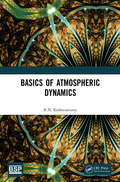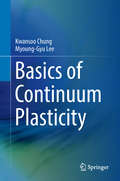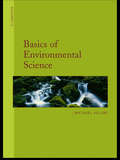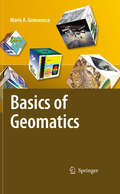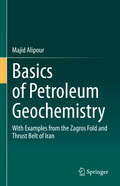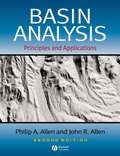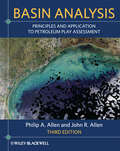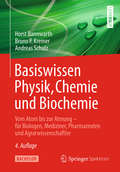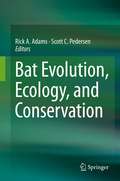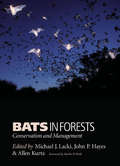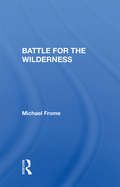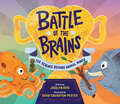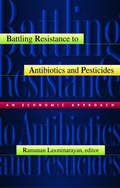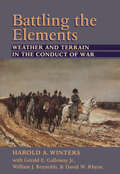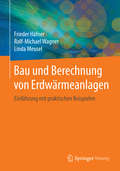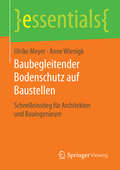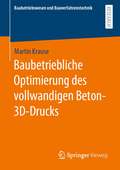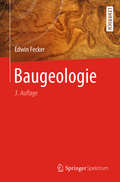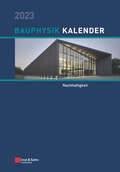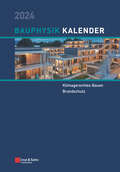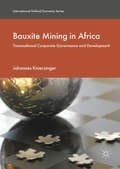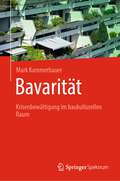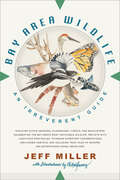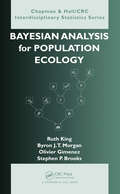- Table View
- List View
Basics of Atmospheric Dynamics
by R.N. KeshavamurtyThe book discusses the basic of atmospheric dynamics where the curved surface of the earth and its rotation around its own axis plays very important roles. The emphasis is on basic physical concepts and the interpretation of equations and the different terms therein. Note: T&F does not sell or distribute the hardback in India, Pakistan, Nepal, Bhutan, Bangladesh and Sri Lanka.
Basics of Continuum Plasticity
by Kwansoo Chung Myoung-Gyu LeeThis book describes the basic principles of plasticity for students and engineers who wish to perform plasticity analyses in their professional lives, and provides an introduction to the application of plasticity theories and basic continuum mechanics in metal forming processes. This book consists of three parts. The first part deals with the characteristics of plasticity and instability under simple tension or compression and plasticity in beam bending and torsion. The second part is designed to provide the basic principles of continuum mechanics, and the last part presents an extension of one-dimensional plasticity to general three-dimensional laws based on the fundamentals of continuum mechanics. Though most parts of the book are written in the context of general plasticity, the last two chapters are specifically devoted to sheet metal forming applications. The homework problems included are designed to reinforce understanding of the concepts involved. This book may be used as a textbook for a one semester course lasting fourteen weeks or longer. This book is intended to be self-sufficient such that readers can study it independently without taking another formal course. However, there are some prerequisites before starting this book, which include a course on engineering mathematics and an introductory course on solid mechanics.
Basics of Environmental Science
by Michael AllabyThe new edition of this popular student text offers an engaging introduction to environmental study. It covers the entire breadth of the environmental sciences, providing concise, non-technical explanations of physical processes and systems and the effects of human activities. In this second edition the scientific background to major environmental issues is clearly explained. These include:* global warming* genetically modified foods* desertification* acid rain* deforestation* human population growth * depleting resources* nuclear power generation* descriptions of the 10 major biomes. Special student text features include illustrations and explanatory diagrams, boxed case studies, concepts and definitions.
Basics of Geomatics
by Mario A. GomarascaThis volume presents a comprehensive and complete treatment. In a systematic way the complex topics and techniques are covered that can be assembled under Geospatial Information namely, Geodesy, Cartography, Photogrammetry, Remote Sensing, Informatics, Acquisition Systems, Global Positioning Systems, Digital Image Processing, Geographic Information Systems, Decision Support Systems, and WebGIS. It describes in detail and at an accessible level - too much math has been avoided - the state of current knowledge. Per chapter a detailed bibliography has been included. As such, it will serve as a working tool not only to geoscientists and geographers but also to engineers, architects, computer scientists, urban planners, specialists in GIS, remote sensing, forestry, agricultural science, soil science geometry, environmental scientists and managers. Applications can be found in security, risk management, monitoring, info-mobility, geo-positioning, food traceability, etc. From the reviews: "The book is rigorous and synthetic, describing with precision the main instruments and methods connected to the multiple techniques today available. The objective pursued is to publish an integrated text, containing simple and comprehensible concepts relevant to experts in Geo-spatial Information." S. Dequal, Professor of Topography and Photogrammetry, DITAG, Polytechnic of Turin, Italy "This book fills a void of telling and showing the reader how remote sensing as a part of geomatics really works. With a clearly presented historical review up to the present time, the author illustrates the basic theories and use of the different remote sensing sensors and how to analyze the data from them for their application. This book would be a complement to the standard remote sensing books and I would highly recommend it for all land oriented professionals and especially graduate students who need a clear explanation of how remote sensing works". Chris J. Johannsen, Professor Emeritus of Agronomy, Department of Agronomy, Purdue University, West Lafayette, Indiana, USA "Basics of Geomatics" is structured in a clear and effective way into thematic chapters that provide a fundamental, yet comprehensive coverage of each of the major disciplines making up the field of Geomatics. Thanks to its clarity and completeness, the text, supplemented by many useful tables and illustrations will serve as a basic reference work for both beginners and experienced readers". John L. van Genderen, Professor, International Institute for Geoinformation Science and Earth Observation (ITC), Department of Earth Observation Science, Enschede, The Netherlands.
Basics of Petroleum Geochemistry: With Examples from the Zagros Fold and Thrust Belt of Iran
by Majid AlipourThis book provides a concise summary about fundamental aspects of petroleum geology and geochemistry for graduate students, primarily from non-English-speaking countries. These fundamentals constitute about 40% of the book, while the remaining 60% deals with regional examples from petroleum geology of the Zagros basin of Iran. The regional examples are prepared using both published and unpublished (proprietary) data. The aim is to familiarize readers with the fundamental aspects of petroleum geochemistry and then provide typical examples from one of the world&’s most prolific petroleum provinces.
Basin Analysis
by John R. Allen Philip A. AllenBasin Analysis is an advanced undergraduate and postgraduate text aimed at understanding sedimentary basins as geodynamic entities. The rationale of the book is that knowledge of the basic principles of the thermo-mechanical behaviour of the lithosphere, the dynamics of the mantle, and the functioning of sediment routing systems provides a sound background for studying sedimentary basins, and is a pre-requisite for the exploitation of resources contained in their sedimentary rocks. The third edition incorporates new developments in the burgeoning field of basin analysis while retaining the successful structure and overall philosophy of the first two editions.The text is divided into 4 parts that establish the geodynamical environment for sedimentary basins and the physical state of the lithosphere, followed by a coverage of the mechanics of basin formation, an integrated analysis of the controls on the basin-fill and its burial and thermal history, and concludes with an application of basin analysis principles in petroleum play assessment, including a discussion of unconventional hydrocarbon plays. The text is richly supplemented by Appendices providing mathematical derivations of a wide range of processes affecting the formation of basins and their sedimentary fills. Many of these Appendices include practical exercises that give the reader hands-on experience of quantitative solutions to important basin analysis processes.Now in full colour and a larger format, this third edition is a comprehensive update and expansion of the previous editions, and represents a rigorous yet accessible guide to problem solving in this most integrative of geoscientific disciplines.Additional resources for this book can be found at: www.wiley.com/go/allen/basinanalysis.
Basin Analysis: Principles and Application to Petroleum Play Assessment
by John R. Allen Philip A. AllenBasin Analysis is an advanced undergraduate and postgraduate text aimed at understanding sedimentary basins as geodynamic entities. The rationale of the book is that knowledge of the basic principles of the thermo-mechanical behaviour of the lithosphere, the dynamics of the mantle, and the functioning of sediment routing systems provides a sound background for studying sedimentary basins, and is a pre-requisite for the exploitation of resources contained in their sedimentary rocks. The third edition incorporates new developments in the burgeoning field of basin analysis while retaining the successful structure and overall philosophy of the first two editions. The text is divided into 4 parts that establish the geodynamical environment for sedimentary basins and the physical state of the lithosphere, followed by a coverage of the mechanics of basin formation, an integrated analysis of the controls on the basin-fill and its burial and thermal history, and concludes with an application of basin analysis principles in petroleum play assessment, including a discussion of unconventional hydrocarbon plays. The text is richly supplemented by Appendices providing mathematical derivations of a wide range of processes affecting the formation of basins and their sedimentary fills. Many of these Appendices include practical exercises that give the reader hands-on experience of quantitative solutions to important basin analysis processes. Now in full colour and a larger format, this third edition is a comprehensive update and expansion of the previous editions, and represents a rigorous yet accessible guide to problem solving in this most integrative of geoscientific disciplines. Additional resources for this book can be found at: www.wiley.com/go/allen/basinanalysis.
Basiswissen Physik, Chemie und Biochemie: Vom Atom bis zur Atmung - für Biologen, Mediziner und Pharmazeuten (Bachelor)
by Bruno P. Kremer Horst Bannwarth Andreas SchulzErste Hilfe in Physik und Chemie: die Basics für das erfolgreiche Bachelorstudium. Physikalische, chemische und biochemische Grundlagen sind unverzichtbar für das Verständnis von Biologie, Medizin, Pharmazie, Ernährungs- und Umweltwissenschaften. Dieses Buch bietet im kompakten Überblick das gesamte Basiswissen dieser Grundlagendisziplinen in leicht verständlichen Texten und Abbildungen, bei Beschränkung auf das wirklich Notwendige, abgestimmt auf die Gegenstandskataloge für den Ersten Abschnitt der Ärztlichen und der Pharmazeutische Prüfung, zur leichteren Orientierung im Grundstudium, und zur optimalen Vorbereitung für die Vor- oder Zwischenprüfung. Die neue Auflage wurde aktuell überarbeitet. Sie enthält auch ein komplett neues Kapitel über Stoffe, Energie und Information. Das ideale Lernbuch zur Physik und Chemie in Biologie, Medizin, Pharmazie, Ernährungs- und Umweltwissenschaften.
Basiswissen Physik, Chemie und Biochemie: Vom Atom bis zur Atmung – für Biologen, Mediziner, Pharmazeuten und Agrarwissenschaftler (Bachelor Ser.)
by Bruno P. Kremer Horst Bannwarth Andreas SchulzDieses Buch bietet im kompakten Überblick das gesamte Basiswissen der Physik, Chemie und Biochemie in leicht verständlichen Texten und Abbildungen, bei Beschränkung auf das wirklich Notwendige. Es ist abgestimmt auf die Gegenstandskataloge für den ersten Abschnitt der Ärztlichen und der Pharmazeutischen Prüfung. Für Studierende der Biologie, der Ernährungs- und Umweltwissenschaften dient es zur leichteren Orientierung im Grundstudium und zur optimalen Vorbereitung für die Vor- oder Zwischenprüfung. Für diese Neuauflage haben die Autoren alle Kapitel durchgängig aktualisiert.
Bat Evolution, Ecology, and Conservation
by Rick A. Adams Scott C. PedersenRecent advances in the study of bats have changed the way we understand this illusive group of mammals. This volume consist of 25 chapters and 57 authors from around the globe all writing on the most recent finding on the evolution, ecology and conservation of bats. The chapters in this book are not intended to be exhaustive literature reviews, but instead extended manuscripts that bring new and fresh perspectives. Many chapters consist of previously unpublished data and are repetitive of new insights and understanding in bat evolution, ecology and conservation. All chapters were peer-reviewed and revised by the authors. Many of the chapters are multi-authored to provide comprehensive and authoritative coverage of the topics.
Bats in Forests: Conservation and Management
by Michael J. LackiAlthough bats are often thought of as cave dwellers, many species depend on forests for all or part of the year. Of the 45 species of bats in North America, more than half depend on forests, using the bark of trees, tree cavities, or canopy foliage as roosting sites. Over the past two decades it has become increasingly clear that bat conservation and management are strongly linked to the health of forests within their range. Initially driven by concern for endangered species—the Indiana bat, for example—forest ecologists, timber managers, government agencies, and conservation organizations have been altering management plans and silvicultural practices to better accommodate bat species. Bats in Forests presents the work of a variety of experts who address many aspects of the ecology and conservation of bats. The chapter authors describe bat behavior, including the selection of roosts, foraging patterns, and seasonal migration as they relate to forests. They also discuss forest management and its influence on bat habitat. Both public lands and privately owned forests are considered, as well as techniques for monitoring bat populations and activity.The important role bats play in the ecology of forests—from control of insects to nutrient recycling—is revealed by a number of authors. Bat ecologists, bat conservationists, forest ecologists, and forest managers will find in this book an indispensable synthesis of the topics that concern them.
Battle For The Wilderness
by Michael FromeThis book focuses on the principles of wilderness, exploring the actual and potential values of wilderness, its ecology, economics, the effect of human impact, and mechanisms to protect small, relatively untouched tracts in or near urban areas in the United States.
Battle of the Brains: The Science Behind Animal Minds
by Jocelyn RishA Junior Library Guild Gold Standard Selection! This hilarious companion to Battle of the Butts examines the way animals use their brainpower for survival in the wild and encourages readers to rank animals based on their intellectual prowess. Birdbrained. Pigheaded. Batty. Bullheaded. When humans want to insult the intelligence of another person, they often compare them to an animal. But animals are smart. Really, really smart. There are animals that use tools. Others that can solve complex problems. Some have excellent memories. A few can even talk to us! With animals having such mighty minds, the question is: who has the best brainpower of them all? That&’s for you to decide! Full of fascinating facts throughout in a fun "battle of the minds" format, The Battle of the Brains includes a glossary and links to sources and activities at the end, making it the perfect read for any curious mind.
Battling Resistance to Antibiotics and Pesticides: An Economic Approach
by Ramanan LaxminarayanThe increasing resistance of bacteria to antibiotics, and pests to pesticides, threatens to undo some of the most remarkable advances made in public health and agriculture during the past century. Though the potential consequences of increased antibiotic and pesticide resistance are far reaching, regulatory efforts to address the problem are at a very early stage. Battling Resistance to Antibiotics and Pesticides moves such discussions forward by presenting cutting edge research and the first comprehensive application of economic tools to analyze how antibiotics and pesticides should be used to maximize their value to society. Laxminarayan and his contributors explore lessons from past experiences with resistance, especially in agriculture. They consider what incentives would be ideal for the individuals who prescribe or apply antibiotics and pesticides, and what would be ideal for the firms engaged in developing and producing these products. The chapters in this groundbreaking book reflect the fact that efforts to combat resistance will require contributions from a broad range of scholars and professionals, representing a broad range of expertise. The analysis demonstrates that, for all these participants, an understanding of economic issues is an essential complement to knowledge of medical or biological factors. The book provides economists with an overview of relevant scientific issues, as well as a variety of analytical approaches to studying the economics of resistance. It offers policymakers detailed analyses of the multiple dimensions of resistance and discusses the future strategies to combat and manage resistance. For professionals in medicine, public health, and agriculture, the book translates the economic approaches into usable guidance for daily practice and decisionmaking.
Battling the Elements: Weather and Terrain in the Conduct of War
by Harold A. WintersThroughout history, from Kublai Khan's attempted invasions of Japan to Rommel's desert warfare, military operations have succeeded or failed on the ability of commanders to incorporate environmental conditions into their tactics. In Battling the Elements, geographer Harold A. Winters and former U.S. Army officers Gerald E. Galloway Jr., William J. Reynolds, and David W. Rhyne, examine the connections between major battles in world history and their geographic components, revealing what role factors such as weather, climate, terrain, soil, and vegetation have played in combat. Each chapter offers a detailed and engaging explanation of a specific environmental factor and then looks at several battles that highlight its effects on military operations. As this cogent analysis of geography and war makes clear, those who know more about the shape, nature, and variability of battleground conditions will always have a better understanding of the nature of combat and at least one significant advantage over a less knowledgeable enemy.
Bau und Berechnung von Erdwärmeanlagen: Einführung mit praktischen Beispielen
by Frieder Häfner Rolf-Michael Wagner Linda MeuselDas Buch charakterisiert die Erdw#65533;rmenutzung, beschreibt die #65533;blichen technischen Anlagen dazu, mit Schwerpunkt auf Erdw#65533;rmesonden (EWS) und ihre Einsatzm#65533;glichkeiten. Danach wird die Berechnung von Erdw#65533;rmeanlagen (Einzel-EWS, Sondenfelder) mit mathematisch-analytischen Verfahren und numerischen Simulationsverfahren dargestellt. Die dazu notwendige Software wird Online als Demo-Version bereitgestellt. In einem weiteren Hauptkapitel werden der Bau von Erdw#65533;rmeanlagen, technische Vorausetzungen,Anforderungen und Genehmigungspraxis dargestellt. Der Betrieb der Anlagen und die vielf#65533;ltigen Nutzungsm#65533;glichkeiten f#65533;r Heizen, Warmwasserbereitung, K#65533;hlen ist in den Hauptkapiteln integriert. Beispielhafte Anlagenmuster werden dimensioniert, bautechnisch beschrieben und wirtschaftlich bewertet. Unter den regenerativen Energiequellen f#65533;r die Geb#65533;udeheizung und -klimatisierung nimmt die Erdw#65533;rme (in Form von Erdw#65533;rmesonden etc. mit W#65533;rmepumpen) den ersten Platz ein. Der j#65533;hrliche Zubau von Erdw#65533;rmeanlagen hat steigende Tendenz.
Baubegleitender Bodenschutz auf Baustellen: Schnelleinstieg für Architekten und Bauingenieure (essentials)
by Ulrike Meyer Anne WienigkIn diesem essentialstellen die Autorinnen den baubegleitenden Bodenschutz als ein wirksamesInstrument zur Vermeidung und Verhinderung von Bodenschäden auf Baustellen vor. Sie veranschaulichen relevante Eigenschaften von Böden, stellen gravierende Schädendes Bodens auf Baustellen vor, zeigen aber auch Maßnahmen zur Bodenschonung auf. Leicht wird erkennbar, dass vor allem die frühzeitige Integration einesbodenkundlichen Baubegleiters bereits in der Planungsphase des Bauvorhabensüber den Erfolg des Bodenschutzes entscheidet. Es gilt, die häufig nahezuirreversiblen Bodenschäden zu vermeiden, deren Rekultivierung nicht nurkostenintensiv, sondern insbesondere sehr zeitaufwändig ist. PraktischeTo-Do-Listen erleichtern die Umsetzung des Bodenschutzes auf Baustellen.
Baubetriebliche Optimierung des vollwandigen Beton-3D-Drucks (Baubetriebswesen und Bauverfahrenstechnik)
by Martin KrauseBeton-3D-Druckverfahren werden es zukünftig ermöglichen, Bauprozesse planbarer, produktiver und nachhaltiger zu realisieren. Durch die höchst anspruchsvollen Randbedingungen auf Baustellen und die im Bauwesen typische Unikatbauweise unterliegen Beton-3D-Druckverfahren besonderen Herausforderungen. Die innovativen Technologien stehen darüber hinaus im wirtschaftlichen Wettbewerb zu konventionellen Bauverfahren. Um die Wirtschaftlichkeit und Prozesssicherheit von Beton-3D-Druckverfahren zu gewährleisten, sind die 3D-Druckstrategie und maßgebende Prozessparameter unter baubetrieblichem Fokus zu optimieren. Dieses Buch beinhaltet eine wissenschaftliche Untersuchung zur baubetrieblichen Optimierung des vollwandigen Beton-3D-Drucks. Speziell werden drei Schwerpunkte genauer untersucht. Im ersten Schwerpunkt werden die verfahrensspezifischen Randbedingungen fokussiert. Schwerpunkt zwei behandelt die wirtschaftliche Optimierung des Druckpfads unter Anwendung von Methoden des Operations Research. Im Schwerpunkt drei wird eine umfassende zeitliche Simulationsstudie am Beispiel eines Einfamilienhauses durchgeführt. Das Buch liefert Erkenntnisse zur Druckzeitoptimierung und der Relation maßgebender Prozessparameter.
Baugeologie
by Edwin FeckerFür den Bauingenieur und den beratenden Ingenieurgeologen ist es unerlässlich, die Einflüsse geologischer Gegebenheiten auf die Bauplanung und -ausführung sowie auf das fertige Bauwerk richtig bewerten zu können.Dieses Buch vermittelt sowohl dem Praktiker als auch dem Studenten das dazu nötige Grundwissen der Allgemeinen Geologie, der Gefüge- und Gesteinskunde. Übersichtlich stellt es die bautechnischen Eigenschaften des Gebirges dar, wobei die Einflüsse von Berg- und Grundwasser auf das ober- oder untertägige Bauen besondere Berücksichtigung finden. Methoden zur Untersuchung von Gestein und Gebirge und zur Vermeidung von Schäden werden vorgestellt. Die aktualisierte 3. Auflage bespricht zusätzlich technische Neuerungen und weist auf die neuesten Normen und Vorschriften hin.
Bauphysik-Kalender 2023: Schwerpunkt: Nachhaltigkeit (Bauphysik-Kalender)
by Nabil A. FouadDie aktuelle Ausgabe des Bauphysik-Kalenders behandelt das gesamte Themenspektrum rund um Nachhaltigkeit bei der Errichtung von Gebäuden. Die Bauindustrie ist der Sektor, der in der Wirtschaft für die höchsten Umweltbelastungen verantwortlich ist. Integrierte Maßnahmen für mehr Klimaschutz und Ressourceneffizienz im Bausektor sind daher ein zentrales Thema der Umwelt- und Nachhaltigkeitspolitik. Die Regulierung zur Energieeinsparung hat bereits dazu geführt, dass der Primärenergiebedarf in der Nutzungsphase von Gebäuden immer weiter reduziert wurde. Es ist nun unabdingbar, die Bewertung von Gebäuden auf die Umweltwirkung und die Auswirkung auf das Klima auszuweiten. In diesem Buch werden die Lebenszyklusanalyse, die Nachhaltigkeitszertifizierung sowie die kreislaufgerechte Verwendung von Bauelementen, Baustoffen und Anlagenteilen umfassend erläutert. Konkretes Hintergrundwissen für klimagerechtes Bauen, für die Ermittlung der Ressourceneffizienz, das Recycling von Dämmstoffen, die Ökobilanzierung und die Zertifizierung werden anhand von Praxisbeispielen aufgezeigt, um Planenden das nötige Rüstzeug für die aktuellen Aufgaben an die Hand zu geben. Auch die Betrachtung von Klima-Fußabdruck und Ressourcen-Fußabdruck mithilfe eines digitalen Gebäudemodells bereits in der Planungsphase ist enthalten. Der Bauphysik-Kalender 2023 bietet eine solide Arbeitsgrundlage und ein verlässliches aktuelles Nachschlagewerk für die Planung in Neubau und Bestand, alle Kapitel bewegen sich nahe an der Ingenieurpraxis. Das Buch enthält Planungshinweise, Konzepte und Praxisbeispiele für nachhaltiges Bauen.
Bauphysik-Kalender 2024: Schwerpunkte: Klimagerechtes Bauen; Brandschutz (Bauphysik-Kalender-eBundle (Ernst & Sohn))
by Nabil A. FouadDer Bauphysik-Kalender 2024 gibt Praxishinweise für die klimagerechte Planung von Gebäuden, aber auch von urbanen Räumen. Diese sind durch die hohen Verdichtungen und Versiegelungen besonders anfällig gegenüber der Klimaveränderung mit häufigeren Extremwetterereignissen. Aber sie sind gestaltbare Orte, an denen durch eine interdisziplinäre und zukunftsorientierte Planung eine weitere Verschärfung des Klimawandels gebremst und die Resilienz von Mensch, Flora und Fauna gegenüber seinen Folgen gestärkt werden kann. Das Buch bietet aktuelles Wissen um bauphysikalische Prozesse zu verstehen, Potenziale von Konstruktionen gezielt auszuschöpfen und die Gebäudetechnik und Automatisierung funktional zu halten. Außerdem werden Tools und Nachweisverfahren getestet und kommentiert, mit deren Hilfe Bilanzen über die Umweltwirkungen von Gebäuden bzw. Bewertungen der Klimaanpassung von Gebäuden ermittelt werden können. Der zweite diesjährige Schwerpunkt Brandschutz widmet sich der Holzbauweise sowie der Untersuchung von Brandeinwirkungen durch E-Fahrzeuge und kraftstoffbetriebene Fahrzeuge in Parkgaragen. Der Bauphysik-Kalender 2024 bietet eine solide Arbeitsgrundlage und ein verlässliches aktuelles Nachschlagewerk für die Planung in Neubau und Bestand, alle Kapitel bewegen sich nahe an der Ingenieurpraxis. Das Buch enthält Planungshinweise, Konzepte und Praxisbeispiele.
Bauxite Mining in Africa: Transnational Corporate Governance and Development (International Political Economy Series)
by Johannes KnierzingerThis book deals with the consequences of the inclusion of African states and communities in the global aluminium chain. The so-called "New Scramble for Africa" of the 2000s illustrated how seriously African living conditions are affected by continuous cycles of boom and bust, and how strongly the quality of life currently depends on the investment decisions and corporate social responsibility policies of transnational corporations. Taking the example of the global production network of bauxite and aluminium, the author focuses on the socio-political aspects of this dependency, which he achieves through the conducting of a series of interviews with various involved parties.
Bavarität: Krisenbewältigung im baukulturellen Raum
by Mark KammerbauerDas Buch befasst sich mit der Architektur, dem Städtebau und der Stadtplanung im Freistaat Bayern aus interdisziplinärer, urbanistischer Sicht. Damit verbundene baukulturelle Partizipation kann zur Bewältigung von Krisen beitragen, wenn sowohl Akteure der Planung und Gestaltung als auch der Nutzung berücksichtigt werden. Ziel des Buches ist, den gebauten Raum Bayerns zu lesen und zu verstehen, ihn einer Kritik zu unterziehen, dabei die Erfolge nicht auszublenden, um Lösungen zu präsentieren und um schließlich Raum für die Reflexion und das Imaginieren zu "bauen". Wenn Menschen die gebaute Umwelt lesen und verstehen, dann informiert das auch ihr Handeln, insbesondere, wenn sie partizipativ an Planungs- und Gestaltungsprozessen für die Errichtung des gebauten Raums beteiligt sind. Um diese Phänomene ihrem Kontext entsprechend zu fassen und zu deuten, schlägt das Buch den Begriff der Bavarität vor. Im Fall des Freistaats Bayern und seines ländlich-städtischen Kontinuums als Ergebnis historischer baulich-räumlicher Entwicklung, durch Tradition und Moderne konturiert, stellt Bavarität eine sozio-kulturelle Leistung dar, deren Ergebnis in der Partizipation aller Beteiligten gründet und nicht endet.
Bay Area Wildlife: An Irreverent Guide
by Jeff MillerLearn about the wildlife of the Bay Area from a lifelong protector of endangered species, and enjoy the wild ride.Jeff Miller's quirky guide to the coolest animal neighbors in the Bay Area will have you gawking at elk, whooping with cranes, and crowning yourself a crossing guard for newts before you know it. Join Jeff on a local safari to meet more than sixty species of mammals, birds, fish, reptiles, amphibians, and insects, and discover the fascinating and sometimes bizarre mating, feeding, and athletic antics of our most charismatic animals.Portraits by Obi Kaufmann, the renowned conservationist artist who created The California Field Atlas, bring each animal to vivid life alongside fun facts, comical photos, and maps to help you scope out the best spots to find your furred, feathered, slimy, and slithery friends. Imbued with the author’s deep compassion for the well-being of our local fauna, Bay Area Wildlife reveals why each of these creatures matters, as well as the threats that loom over our region's incredible biodiversity.
Bayesian Analysis for Population Ecology (Chapman & Hall/CRC Interdisciplinary Statistics)
by Ruth King Byron Morgan Olivier Gimenez Steve BrooksNovel Statistical Tools for Conserving and Managing PopulationsBy gathering information on key demographic parameters, scientists can often predict how populations will develop in the future and relate these parameters to external influences, such as global warming. Because of their ability to easily incorporate random effects, fit state-space mode
